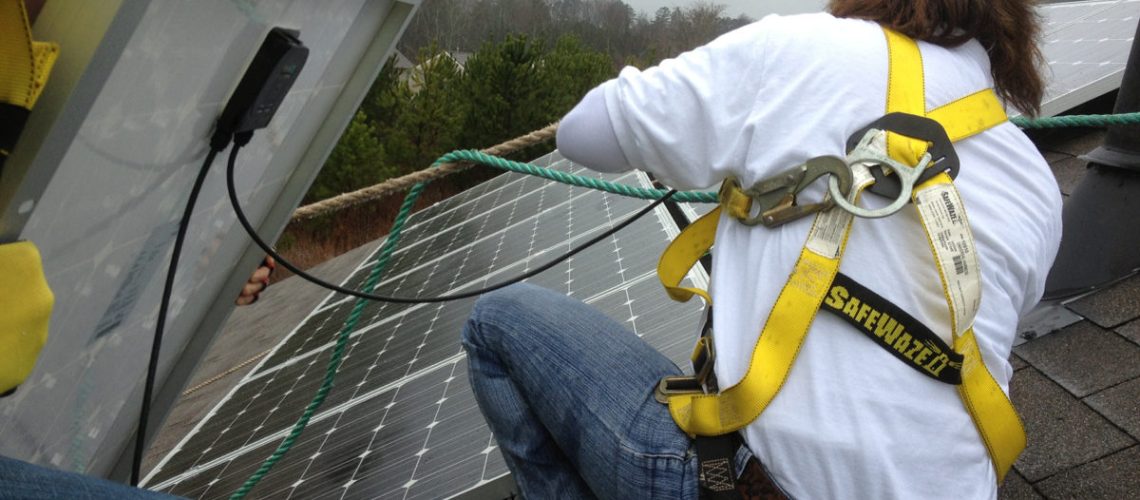Since July, only two customers have installed solar in NIPSCO’s 1.2 million customer territory following a new net metering rulemaking. The case has been elevated to the Supreme Court.
On July 1, 2022, regulators and utilities in the state of Indiana killed rooftop solar.
Rulemaking proceedings led to the slashing of net metering, a program in which utilities pay customers for their excess solar generation. Net metering has been pivotal in launching rooftop solar, a technology that supports climate resilience in the grid, launched local businesses and helps residents save on their electric bills.
Indiana Governor Eric Holcomb signed a bill in 2017 that put the state on a path to phasing out net metering by 2047. Meanwhile, it let utilities begin paying solar customers a lower rate when solar penetration reached 1.5% of their summer peak load, or by July 2022. Net metering rates are often lowered over time as a way to avoid cross-subsidization of solar owners by non-solar owners, and a way to retain profits for electric utilities. However, national laboratory studies have shown that until rooftop solar reaches 10% of the grid mix, it leads to a negligible cost to utility companies, and can instead lead to cost savings.
Utilities in Indiana wasted no time in aggressively slashing net metering rates. On July 1, 2022, investor-owned utility CenterPoint Energy switched from monthly net metering to a new model known as “instantaneous netting.” Under instantaneous netting, customers pay the full retail rate for all power used from the grid, and all solar power sent back to the grid is paid at the much lower “excess distribution generation” rate.
Overnight, CenterPoint was approved by the Indiana Utility Regulatory Commission to pay their customers $0.031/kWh for solar, and northern Indiana utility NIPSCO was approved at $0.026/kWh. Since then, net metering payment rates have creeped up to about four or five cents per kWh as power prices have increased considerably following the invasion of Ukraine.
The new rates altered the estimated typical residential solar payback period from the seven to 10 years to 21 years or more, a value proposition that Hoosiers haven’t been able to stomach.
The rates are so unpalatable that only two NIPSCO customers have installed rooftop solar since July 1, 2022, reported Ben Inskeep, program director at Citizens Action Coalition (CAC). NIPSCO serves over 1.2 million customers.
CenterPoint has had roughly 100 rooftop solar installations, and across the state’s four other utility companies, only 124 customers have applied to go solar under the new rates, reports the Indy Star.
The ratemaking case has found its way to the Supreme Court. Solar advocates argue that the 2017 Holcomb bill never had provisions that allowed for “instantaneous netting.”
“We prefer to call this ‘no netting’, because there really is no netting that’s happening,” said Kerwin Olson, executive director of CAC.
The shorter the interval of netting excess solar production, the lower the payments to rooftop solar customers. Analysis by CAC found that once the Investment Tax Credit (ITC) from the Inflation Reduction Act steps down to zero, payback periods for rooftop solar could exceed 30 years.
The ratemaking debacle highlights an ongoing critical issue for residential solar rollout: uncertainty. Reducing uncertainty was one of the main motivations for the industry push to have the ITC extended for a decade, rather than the piecemeal way it had been extended historically.
“It’s hard to say what your compensation will be in the future — it will change every single year,” said Inskeep.
“You’re making a 25-year investment, but the value is updated on an annual basis. You have no ability to see if your investment will pay off. Utilities never make large investments for 30-year assets without having certainty for that cost recovery. Now they’re asking residential customers to take that risk — with no ability to understand when their investment will pay off or if it will never pay off,” he said.
A similar battle between utilities and a coalition of consumer advocates, environmentalists and solar industry members is raging across the nation in various markets. The nation will be watching Indiana’s Supreme Court case as well as the ruling on Net Metering 3.0 in California as waypoints to determine the fate of rooftop solar.



